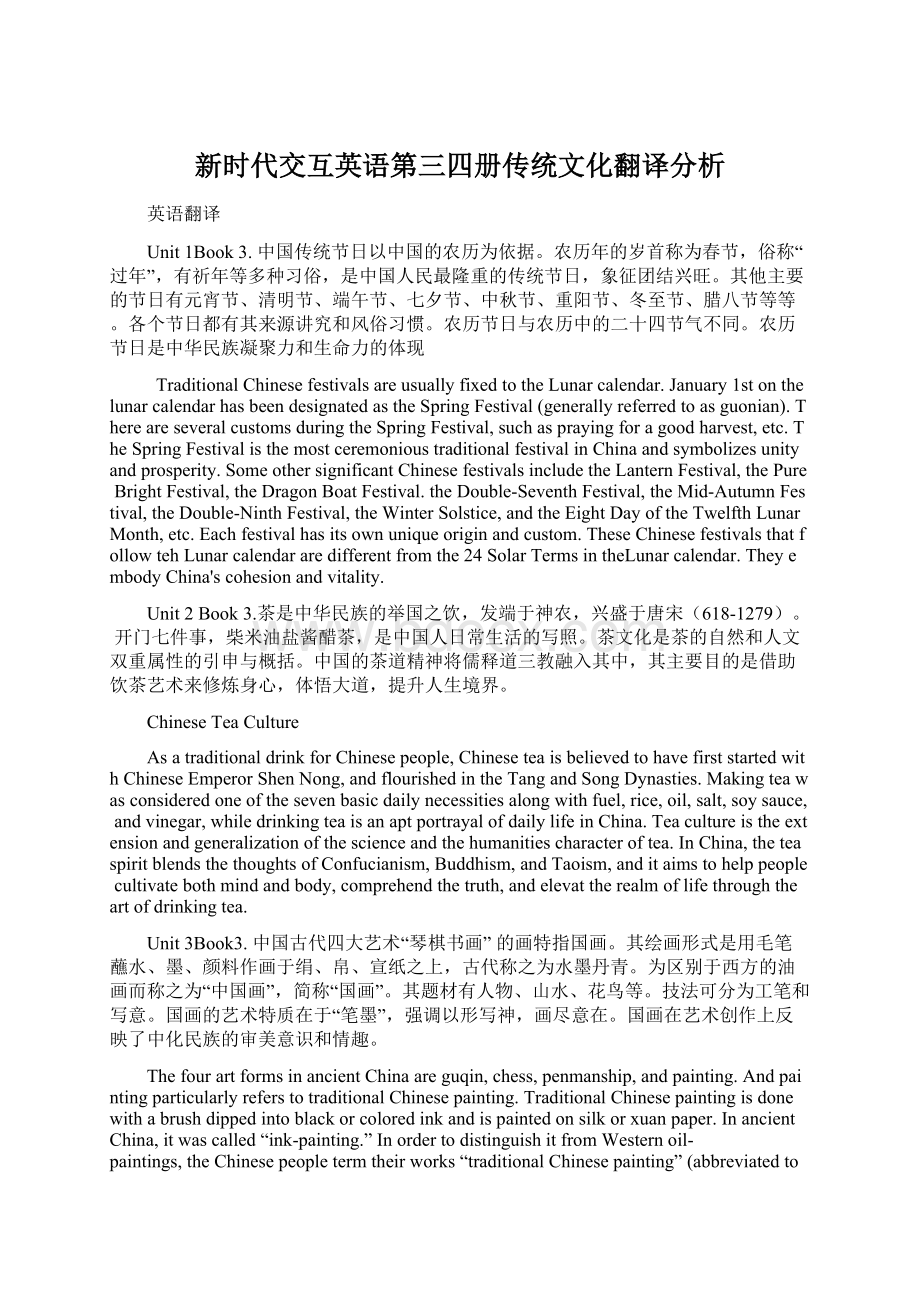新时代交互英语第三四册传统文化翻译分析.docx
《新时代交互英语第三四册传统文化翻译分析.docx》由会员分享,可在线阅读,更多相关《新时代交互英语第三四册传统文化翻译分析.docx(6页珍藏版)》请在冰豆网上搜索。

新时代交互英语第三四册传统文化翻译分析
英语翻译
Unit1Book3. 中国传统节日以中国的农历为依据。
农历年的岁首称为春节,俗称“过年”,有祈年等多种习俗,是中国人民最隆重的传统节日,象征团结兴旺。
其他主要的节日有元宵节、清明节、端午节、七夕节、中秋节、重阳节、冬至节、腊八节等等。
各个节日都有其来源讲究和风俗习惯。
农历节日与农历中的二十四节气不同。
农历节日是中华民族凝聚力和生命力的体现
Traditional Chinese festivals are usually fixed to the Lunar calendar. January 1st on the lunar calendar has been designated as the Spring Festival (generally referred to as guonian). There are several customs during the Spring Festival, such as praying for a good harvest, etc. The Spring Festival is the most ceremonious traditional festival in China and symbolizes unity and prosperity. Some other significant Chinese festivals include the Lantern Festival, the Pure Bright Festival, the Dragon Boat Festival. the Double-Seventh Festival, the Mid-Autumn Festival, the Double-Ninth Festival, the Winter Solstice, and the Eight Day of the Twelfth Lunar Month, etc. Each festival has its own unique origin and custom. These Chinese festivals that follow teh Lunar calendar are different from the 24 Solar Terms in theLunar calendar. They embody China's cohesion and vitality.
Unit2Book3.茶是中华民族的举国之饮,发端于神农,兴盛于唐宋(618-1279)。
开门七件事,柴米油盐酱醋茶,是中国人日常生活的写照。
茶文化是茶的自然和人文双重属性的引申与概括。
中国的茶道精神将儒释道三教融入其中,其主要目的是借助饮茶艺术来修炼身心,体悟大道,提升人生境界。
Chinese Tea Culture
As a traditional drink for Chinese people, Chinese tea is believed to have first started with Chinese Emperor Shen Nong, and flourished in the Tang and Song Dynasties. Making tea was considered one of the seven basic daily necessities along with fuel, rice, oil, salt, soy sauce, and vinegar, while drinking tea is an apt portrayal of daily life in China. Tea culture is the extension and generalization of the science and the humanities character of tea. In China, the tea spirit blends the thoughts of Confucianism, Buddhism, and Taoism, and it aims to help people cultivate both mind and body, comprehend the truth, and elevat the realm of life through the art of drinking tea.
Unit3Book3. 中国古代四大艺术“琴棋书画” 的画特指国画。
其绘画形式是用毛笔蘸水、墨、颜料作画于绢、帛、宣纸之上,古代称之为水墨丹青。
为区别于西方的油画而称之为“中国画”,简称“国画”。
其题材有人物、山水、花鸟等。
技法可分为工笔和写意。
国画的艺术特质在于“笔墨”,强调以形写神,画尽意在。
国画在艺术创作上反映了中化民族的审美意识和情趣。
The four art forms in ancient China are guqin, chess, penmanship, and painting. And painting particularly refers to traditional Chinese painting. Traditional Chinese painting is done with a brush dipped into black or colored ink and is painted on silk or xuan paper. In ancient China, it was called “ink-painting.” In order to distinguish it from Western oil-paintings, the Chinese people term their works “traditional Chinese painting” (abbreviated to “Chinese painting”.) The subject matters of Chinese paintings are typically figures, landscapes, birds and flowers. The drawing skills and techniques employed by the Chinese painters can be divided into two forms:
fine brushwork and free-hand brushwork. The artistic characteristics lie in “the writing brush and ink.” Chinese painting emphasizes using the shape to convey the feelings of the painter. Even though a painting is a finished product, it endlessly conveys a meaning. In terms of the artistic creation, traditional Chinese painting is a reflection of the aesthetic consciousness and artistic sentiment of the Chinese people.
Unit4Book3.中国是酒的故乡。
古人将酒的作用归纳为治病、养生、礼仪三类。
酒文化是中华饮食文化的重要组成部分, 它的精神文化价值体现在社会政治生活、文学艺术乃至人生态度、审美情趣等诸多方面。
无酒不成宴,酒筹文化是中国合餐制的产物。
宴席上的酒令五花八门,猜拳、文字令、筹令等都富有丰富的文化内涵,若胸中无数,则难以自如应对。
China is the home of wine and spirits. The functions of wine and spirits were classified by the ancients into three kinds:
treating patients, keeping in good health, and showing politeness and respect to others. China's wine and spirits culture is an important part of Chinese food culture, and it embodies its valuesin many aspects, such as in social and political life, literature and art, life philosophies, aesthetics, and so on. There is an old saying which goes, " It is not a banquet without wine." Under the custom of having dinner together in China, drinking games were therefore introduced. There are many kinds of banquet betting and drinking games, like the morra ( a finger-guessing game), wine/spirtis words, wine/spirits chips (a drinking game), all with rich cultural connotations. In reality, it is difficult to win unless you have a card up your sleeve.
5. 中国石窟
中国石窟组要反映的是佛教文化艺术。
敦煌莫高窟、大同云冈石窟、洛阳龙门石窟、天水麦积山石窟,号称中国四大石窟艺术景观。
佛教石窟随山雕凿、彩绘,形象生动自然,将崇尚美与世俗情融为一体,把天然造化与人工创造有机结合,是由建筑、绘画、雕塑等组成的博大精深、绚丽夺目的综合艺术殿堂。
其艺术成就为世界瞩目,已成为重要的世界文化遗产。
ChineseGrottoes
ChinesegrottoesmainlyreflecttheartofBuddhistculture.InChina,therearefourmajorartlandscapeofgrottoes:
theMogaoGrottoesatDunhuang,theYungangGrottoesatDatong,theLongmenGrottoesatLuoyang,andtheMaijishanGrottoesatTianshui.Carvedandpaintedonmountains,theBuddhistgrottoesminglebothsublimityandsecularfeelingstogether,presentingusavividandnaturalappearance.Theyembodythesystematiccombinationofboththeexceptionalartistryofgreatnatureandtheextremelyfinecraftsmanshipofmankind.TheChin